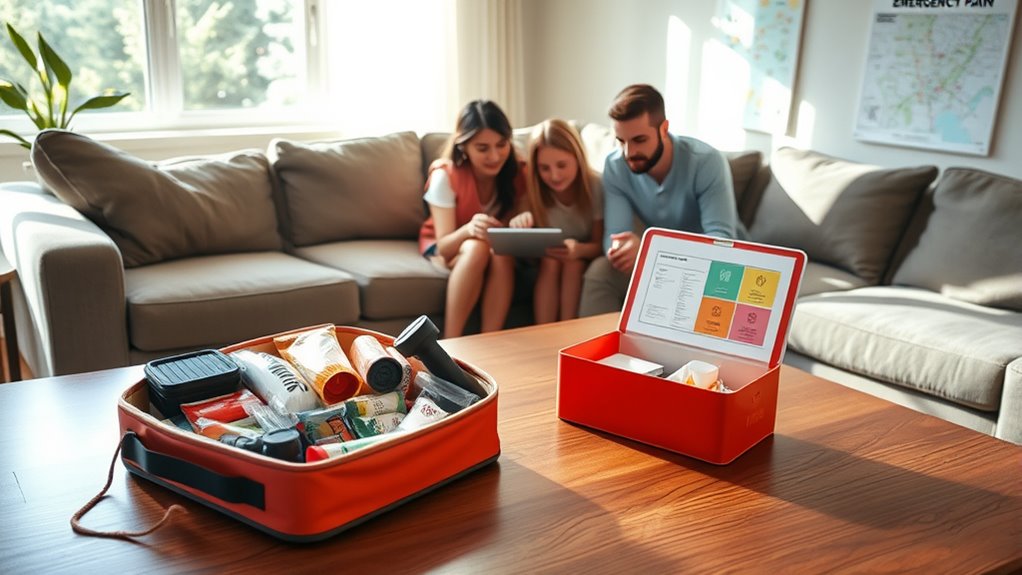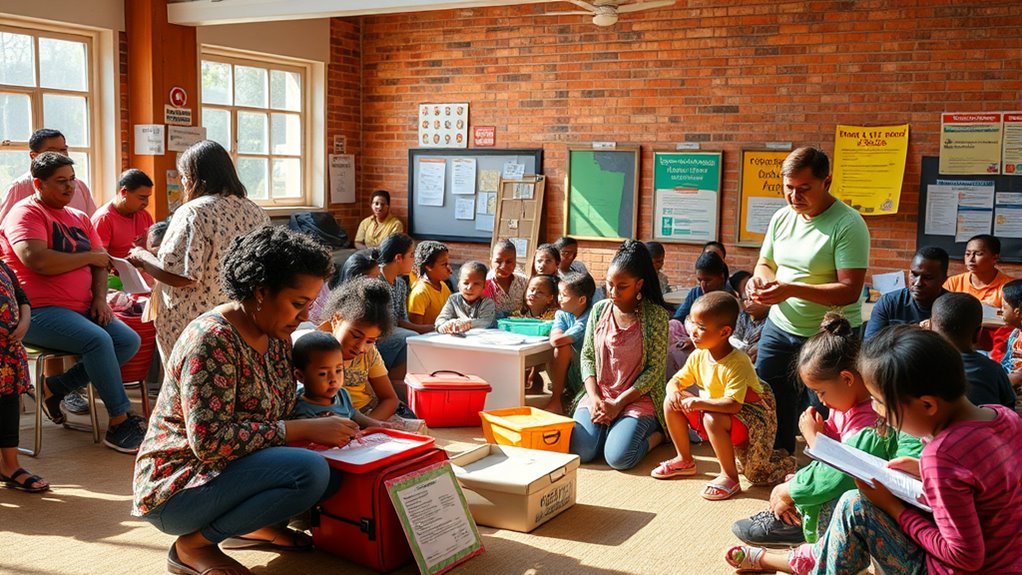To keep your family safe during emergencies, familiarize yourself with local disasters and warning systems. Create an emergency plan that assigns roles to family members and involves children to ease their anxiety. Build a disaster kit with essentials and connect with neighbors for support. If you have children with disabilities, make certain your plan meets their specific needs. There’s more to explore about effective strategies and resources to enhance your family’s preparedness.
Key Takeaways
- Familiarize your family with local disaster risks and emergency procedures at schools and workplaces.
- Create a disaster kit with essential supplies, including food, water, and medications for at least three days.
- Develop a clear communication plan and assign roles to each family member for effective coordination during emergencies.
- Involve children in emergency planning to alleviate their anxiety and promote understanding of safety measures.
- Build a support network with neighbors and local organizations to enhance community resilience during disasters.
Understanding Household Preparedness

Understanding household preparedness is essential for ensuring your family’s safety during emergencies. Start by familiarizing yourself with local disasters and their warning systems. Knowing emergency procedures at your workplace, schools, and other frequent spots is significant. Consider getting a NOAA Weather Radio for essential updates. Identify local emergency organizations and keep their contact details handy. Engage in first aid and CPR training; this knowledge can be lifesaving.
Developing a disaster kit is equally important. Stock at least a three-day supply of non-perishable food and one gallon of water per person daily. Include a first aid kit, flashlight, and communication tools like a battery-powered radio. Additionally, obtaining first aid and CPR training can empower family members to act confidently during emergencies. Don’t forget personal hygiene items and supplies for your pets. Being prepared means being proactive!
The Role of Family Dynamics in Emergency Planning

When families work together in emergency planning, they enhance their overall preparedness and response effectiveness.
Start by establishing a clear communication plan, designating emergency contacts, and deciding how to reach each other during a crisis. Texting often works better than calling when networks get congested.
Assign specific roles to each family member—like child care, first aid, or communication duties—based on strengths. Regularly discuss and practice these roles to guarantee everyone knows their responsibilities. Emergency plans should include handling medical emergencies, active shooters, and natural disasters.
Involve children in the planning process; it helps them understand and reduces anxiety during emergencies.
Finally, strengthen your support network with neighbors to enhance community resilience. Together, these steps create a united front in facing emergencies.
Special Considerations for Families With Children With Disabilities

Families with children who’ve disabilities face unique challenges during emergencies, making tailored planning essential.
Start by creating a thorough emergency plan that considers your child’s specific needs, including mobility and medical requirements. Develop a communication plan using alternative methods if your child has difficulty expressing themselves.
Identify safe shelters and accessible transportation options for evacuation. Stock emergency supplies, like extra medications and necessary devices. Verify you have backup power sources for life-sustaining equipment and store additional medical supplies at home and school.
Build a support network of family and friends who understand your child’s needs, and practice evacuation procedures to verify everyone knows what to do.
Regularly review and update your plan to keep it effective.
Childcare Providers and Emergency Response

Childcare providers play an essential role in guaranteeing the safety of children during emergencies, similar to how families must consider their unique needs. You should recognize that common risks include injuries, inclement weather, and technology failures. It’s critical to assess hazards specific to your community and facility, especially since infants and toddlers require additional planning for evacuation. Family child care providers often work alone without additional adult support during emergencies, making their evacuation plans less comprehensive than those in larger centers. Developing a thorough emergency plan with clear evacuation procedures and regular drills is fundamental. Training staff on these protocols guarantees everyone knows their responsibilities. Collaborating with local emergency services can enhance your preparedness. Finally, keep emergency supply kits updated and maintain communication devices handy to respond effectively during any crisis. Prioritize these strategies to create a safe environment for the children in your care.
Effective Communication Strategies During Disasters

Effective communication during disasters is essential, as it can greatly influence how communities respond and recover. To guarantee timely and accurate information, develop a thorough disaster communication plan.
Identify all stakeholders, including government officials and community organizations, to enhance collaboration. Craft clear, concise messages tailored to different audiences, avoiding jargon for better understanding.
Utilize social media for real-time updates, as many people rely on it for news. Establish a crisis communication team to maintain consistent messaging across all channels.
Don’t forget to verify information to prevent misinformation and build trust through transparency. Engage with your community, and create feedback mechanisms to adapt to their needs during emergencies.
This proactive approach can save lives and strengthen community resilience.
Addressing Socioeconomic Factors in Preparedness Efforts

While effective communication strategies play a vital role in disaster response, addressing socioeconomic factors is equally important for thorough preparedness efforts.
Lower-income households face significant barriers, often prioritizing immediate needs over disaster preparedness. They may lack the funds to stockpile emergency supplies or access important resources, making them more vulnerable during crises.
High-density areas further complicate evacuation efforts, especially for vulnerable populations like the elderly and children.
To enhance preparedness, it’s essential to engage these communities and provide support programs that offer access to resources and information.
Frequently Asked Questions
What Types of Disasters Should My Family Prepare For?
You should prepare for both natural and man-made disasters. Assess your area’s specific risks, like hurricanes, earthquakes, or wildfires.
Don’t forget about possible hazards from industrial accidents or public health emergencies. It’s crucial to create a thorough plan that includes evacuation routes and communication strategies.
Your family’s safety hinges on understanding these potential disasters and being proactive in your preparations, ensuring everyone knows what to do in an emergency.
How Can I Create a Family Emergency Communication Plan?
To create a family emergency communication plan, start by gathering contact info for family members and key contacts.
Choose an out-of-town contact for reconnection and document any special needs.
Share printed copies of the plan, keep them accessible, and make certain everyone has a communication method.
Regularly practice the plan through drills and meetings, updating it based on feedback.
Don’t forget to include meeting locations and emergency alerts for added safety.
What Items Should Be Included in an Emergency Supply Kit?
Imagine a dark night, the wind howling outside, and you’re prepared.
Your emergency supply kit should include one gallon of water per person daily, non-perishable food for three days, and a first aid kit stocked with essentials.
Don’t forget a flashlight with extra batteries, a battery-powered radio for updates, and personal items like prescription medications.
Keep important documents and some cash handy.
These items can turn chaos into comfort when you need it most.
How Often Should We Review Our Emergency Plan?
You should review your emergency plan at least once a year to keep it effective and relevant.
However, if there are changes in your family dynamics, staff, or living situation, it’s wise to make updates more frequently.
Regular reviews help you identify gaps and guarantee you’re ready for any emergencies.
Don’t forget to incorporate feedback from drills and document any changes to maintain an accurate and compliant plan.
Where Can I Find Local Emergency Training Courses?
Finding local emergency training courses is like uncovering hidden treasures in your community.
Start by checking Ready.gov and your local FEMA Training Catalog for accessible resources. The American Red Cross often offers both online and in-person options.
If you’re in Massachusetts, look into the Local Public Health Institute for tailored courses.
Don’t forget about Community Emergency Response Teams (CERT)—they provide hands-on training that can empower you to act when it matters most.
Conclusion
In the chaos of an emergency, think of your family as a well-rehearsed orchestra. Each member plays a unique instrument, and when disaster strikes, harmony matters. Just like a conductor guides the music, your preparedness plan guarantees everyone knows their role. Remember, 60% of families aren’t ready for emergencies. Don’t let your family be a discordant note. Take the time to plan together, and you’ll create a symphony of safety that resonates through any storm.









